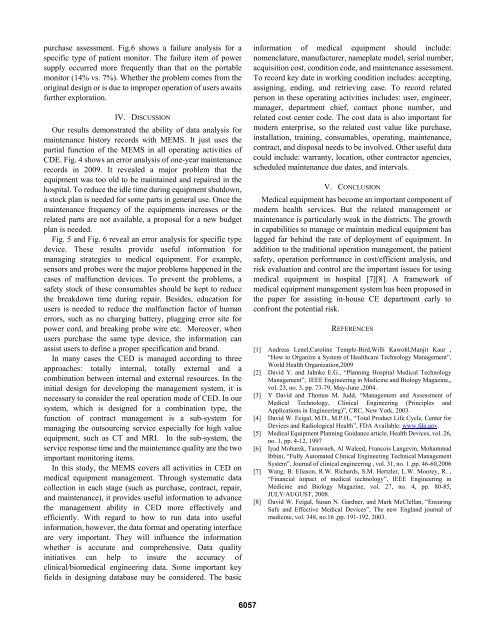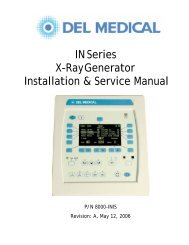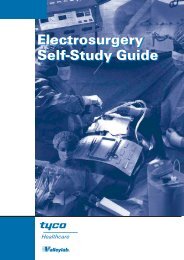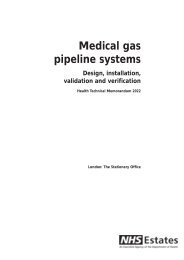A Framework of Medical Equipment Management System for In ...
A Framework of Medical Equipment Management System for In ...
A Framework of Medical Equipment Management System for In ...
You also want an ePaper? Increase the reach of your titles
YUMPU automatically turns print PDFs into web optimized ePapers that Google loves.
purchase assessment. Fig.6 shows a failure analysis <strong>for</strong> a<br />
specific type <strong>of</strong> patient monitor. The failure item <strong>of</strong> power<br />
supply occurred more frequently than that on the portable<br />
monitor (14% vs. 7%). Whether the problem comes from the<br />
original design or is due to improper operation <strong>of</strong> users awaits<br />
further exploration.<br />
IV. DISCUSSION<br />
Our results demonstrated the ability <strong>of</strong> data analysis <strong>for</strong><br />
maintenance history records with MEMS. It just uses the<br />
partial function <strong>of</strong> the MEMS in all operating activities <strong>of</strong><br />
CDE. Fig. 4 shows an error analysis <strong>of</strong> one-year maintenance<br />
records in 2009. It revealed a major problem that the<br />
equipment was too old to be maintained and repaired in the<br />
hospital. To reduce the idle time during equipment shutdown,<br />
a stock plan is needed <strong>for</strong> some parts in general use. Once the<br />
maintenance frequency <strong>of</strong> the equipments increases or the<br />
related parts are not available, a proposal <strong>for</strong> a new budget<br />
plan is needed.<br />
Fig. 5 and Fig. 6 reveal an error analysis <strong>for</strong> specific type<br />
device. These results provide useful in<strong>for</strong>mation <strong>for</strong><br />
managing strategies to medical equipment. For example,<br />
sensors and probes were the major problems happened in the<br />
cases <strong>of</strong> malfunction devices. To prevent the problems, a<br />
safety stock <strong>of</strong> these consumables should be kept to reduce<br />
the breakdown time during repair. Besides, education <strong>for</strong><br />
users is needed to reduce the malfunction factor <strong>of</strong> human<br />
errors, such as no charging battery, plugging error site <strong>for</strong><br />
power cord, and breaking probe wire etc. Moreover, when<br />
users purchase the same type device, the in<strong>for</strong>mation can<br />
assist users to define a proper specification and brand.<br />
<strong>In</strong> many cases the CED is managed according to three<br />
approaches: totally internal, totally external and a<br />
combination between internal and external resources. <strong>In</strong> the<br />
initial design <strong>for</strong> developing the management system, it is<br />
necessary to consider the real operation mode <strong>of</strong> CED. <strong>In</strong> our<br />
system, which is designed <strong>for</strong> a combination type, the<br />
function <strong>of</strong> contract management is a sub-system <strong>for</strong><br />
managing the outsourcing service especially <strong>for</strong> high value<br />
equipment, such as CT and MRI. <strong>In</strong> the sub-system, the<br />
service response time and the maintenance quality are the two<br />
important monitoring items.<br />
<strong>In</strong> this study, the MEMS covers all activities in CED on<br />
medical equipment management. Through systematic data<br />
collection in each stage (such as purchase, contract, repair,<br />
and maintenance), it provides useful in<strong>for</strong>mation to advance<br />
the management ability in CED more effectively and<br />
efficiently. With regard to how to run data into useful<br />
in<strong>for</strong>mation, however, the data <strong>for</strong>mat and operating interface<br />
are very important. They will influence the in<strong>for</strong>mation<br />
whether is accurate and comprehensive. Data quality<br />
initiatives can help to insure the accuracy <strong>of</strong><br />
clinical/biomedical engineering data. Some important key<br />
fields in designing database may be considered. The basic<br />
6057<br />
in<strong>for</strong>mation <strong>of</strong> medical equipment should include:<br />
nomenclature, manufacturer, nameplate model, serial number,<br />
acquisition cost, condition code, and maintenance assessment.<br />
To record key date in working condition includes: accepting,<br />
assigning, ending, and retrieving case. To record related<br />
person in these operating activities includes: user, engineer,<br />
manager, department chief, contact phone number, and<br />
related cost center code. The cost data is also important <strong>for</strong><br />
modern enterprise, so the related cost value like purchase,<br />
installation, training, consumables, operating, maintenance,<br />
contract, and disposal needs to be involved. Other useful data<br />
could include: warranty, location, other contractor agencies,<br />
scheduled maintenance due dates, and intervals.<br />
V. CONCLUSION<br />
<strong>Medical</strong> equipment has become an important component <strong>of</strong><br />
modern health services. But the related management or<br />
maintenance is particularly weak in the districts. The growth<br />
in capabilities to manage or maintain medical equipment has<br />
lagged far behind the rate <strong>of</strong> deployment <strong>of</strong> equipment. <strong>In</strong><br />
addition to the traditional operation management, the patient<br />
safety, operation per<strong>for</strong>mance in cost/efficient analysis, and<br />
risk evaluation and control are the important issues <strong>for</strong> using<br />
medical equipment in hospital [7][8]. A framework <strong>of</strong><br />
medical equipment management system has been proposed in<br />
the paper <strong>for</strong> assisting in-house CE department early to<br />
confront the potential risk.<br />
REFERENCES<br />
[1] Andreas Lenel,Caroline Temple-Bird,Willi Kawohl,Manjit Kaur ,<br />
“How to Organize a <strong>System</strong> <strong>of</strong> Healthcare Technology <strong>Management</strong>”,<br />
World Health Organization,2009<br />
[2] David Y. and Jahnke E.G., “Planning Hospital <strong>Medical</strong> Technology<br />
<strong>Management</strong>”, IEEE Engineering in Medicine and Biology Magazine,,<br />
vol. 23, no. 3, pp. 73-79, May-June ,2004.<br />
[3] Y David and Thomas M. Judd, “<strong>Management</strong> and Assessment <strong>of</strong><br />
<strong>Medical</strong> Technology, Clinical Engineering (Principles and<br />
Applications in Engineering)”, CRC, New York, 2003.<br />
[4] David W. Feigal, M.D., M.P.H., “Total Product Life Cycle, Center <strong>for</strong><br />
Devices and Radiological Health”, FDA Available: www.fda.gov.<br />
[5] <strong>Medical</strong> <strong>Equipment</strong> Planning Guidance article, Health Devices, vol. 26,<br />
no. 1, pp. 4-12, 1997<br />
[6] Iyad Mobarek, Tarawneh, Al Waleed, Francois Langevin, Mohammad<br />
Ibbini, “Fully Automated Clinical Engineering Technical <strong>Management</strong><br />
<strong>System</strong>”, Journal <strong>of</strong> clinical engineering , vol. 31, no. 1 ,pp. 46-60,2006<br />
[7] Wang, B. Eliason, R.W. Richards, S.M. Hertzler, L.W. Moorey, R. ,<br />
“Financial impact <strong>of</strong> medical technology”, IEEE Engineering in<br />
Medicine and Biology Magazine, vol. 27, no. 4, pp. 80-85,<br />
JULY/AUGUST, 2008.<br />
[8] David W. Feigal, Susan N. Gardner, and Mark McClellan, “Ensuring<br />
Safe and Effective <strong>Medical</strong> Devices”, The new England journal <strong>of</strong><br />
medicine, vol. 348, no.16 ,pp. 191-192, 2003.










